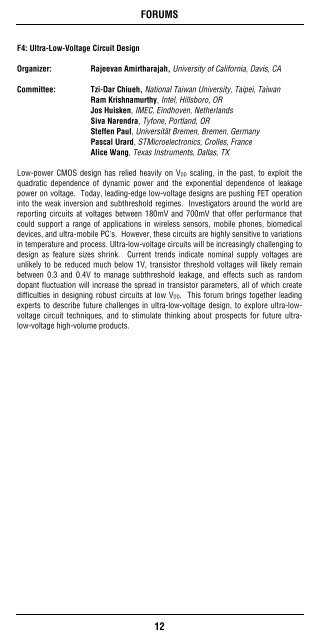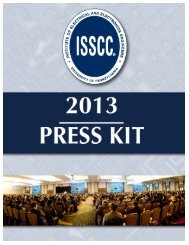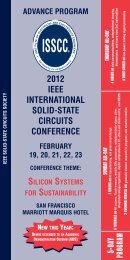Download PDF - International Solid-State Circuits Conference
Download PDF - International Solid-State Circuits Conference
Download PDF - International Solid-State Circuits Conference
Create successful ePaper yourself
Turn your PDF publications into a flip-book with our unique Google optimized e-Paper software.
F4: Ultra-Low-Voltage Circuit Design<br />
FORUMS<br />
Organizer: Rajeevan Amirtharajah, University of California, Davis, CA<br />
Committee: Tzi-Dar Chiueh, National Taiwan University, Taipei, Taiwan<br />
Ram Krishnamurthy, Intel, Hillsboro, OR<br />
Jos Huisken, IMEC, Eindhoven, Netherlands<br />
Siva Narendra, Tyfone, Portland, OR<br />
Steffen Paul, Universität Bremen, Bremen, Germany<br />
Pascal Urard, STMicroelectronics, Crolles, France<br />
Alice Wang, Texas Instruments, Dallas, TX<br />
Low-power CMOS design has relied heavily on VDD scaling, in the past, to exploit the<br />
quadratic dependence of dynamic power and the exponential dependence of leakage<br />
power on voltage. Today, leading-edge low-voltage designs are pushing FET operation<br />
into the weak inversion and subthreshold regimes. Investigators around the world are<br />
reporting circuits at voltages between 180mV and 700mV that offer performance that<br />
could support a range of applications in wireless sensors, mobile phones, biomedical<br />
devices, and ultra-mobile PC's. However, these circuits are highly sensitive to variations<br />
in temperature and process. Ultra-low-voltage circuits will be increasingly challenging to<br />
design as feature sizes shrink. Current trends indicate nominal supply voltages are<br />
unlikely to be reduced much below 1V, transistor threshold voltages will likely remain<br />
between 0.3 and 0.4V to manage subthreshold leakage, and effects such as random<br />
dopant fluctuation will increase the spread in transistor parameters, all of which create<br />
difficulties in designing robust circuits at low VDD. This forum brings together leading<br />
experts to describe future challenges in ultra-low-voltage design, to explore ultra-lowvoltage<br />
circuit techniques, and to stimulate thinking about prospects for future ultralow-voltage<br />
high-volume products.<br />
12




